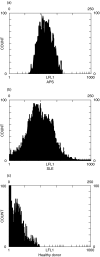Beta-2-glycoprotein I expression on monocytes is increased in anti-phospholipid antibody syndrome and correlates with tissue factor expression
- PMID: 12780700
- PMCID: PMC1808726
- DOI: 10.1046/j.1365-2249.2003.02180.x
Beta-2-glycoprotein I expression on monocytes is increased in anti-phospholipid antibody syndrome and correlates with tissue factor expression
Abstract
It is well known that monocytes may play an active role in thrombogenesis, since they may express on their surface tissue factor, the major initiator of the clotting cascade. The results of this investigation demonstrate beta-2-glycoprotein I (beta2-GPI) mRNA expression by human peripheral blood monocytes, indicating that these cells synthesize beta2-GPI. In addition, we show beta2-GPI expression on cell surface of these cells by flow cytometric analysis, and the presence of this protein in cell lysate by Western blot. Interestingly, beta2-GPI expression on monocytes is significantly increased in patients with anti-phospholipid syndrome (APS) or systemic lupus erythematosus (SLE) as against healthy blood donors and correlates with tissue factor expression on monocytes. These findings support the view that monocytes are able to synthesize beta2-GPI and suggest that patients with APS may have increased beta2-GPI exposure on cell surface, which leads to persistently high monocyte tissue factor expression and consequently to a prothrombotic diathesis.
Figures





References
-
- Hughes GRV. The anticardiolipin syndrome. Clin Exp Rheumatol. 1985;3:285–6. - PubMed
-
- Hughes GRV, Harris EN, Gharavi AE. The anticardiolipin syndrome. J Rheumatol. 1986;13:486–9. - PubMed
-
- Wilson WA, Gharavi AE, Koike T, et al. International consensus statement on preliminary classification criteria for definite antiphospholipid syndrome. Arthritis Rheum. 1999;42:1309–11. - PubMed
-
- Galli M, Confurius P, Maassen C, et al. Anticardiolipin antibodies (ACA) directed not to cardiolipin but to a plasma protein cofactor. Lancet. 1990;355:1544–7. - PubMed
-
- Hunt J, Krilis S. The fifth domain of β2-glycoprotein I contains a phospholipid binding site (Cys 281-Cys 288) and a region recognized by anticardiolipin antibodies. J Immunol. 1994;152:653–9. - PubMed
MeSH terms
Substances
LinkOut - more resources
Full Text Sources
Other Literature Sources
Miscellaneous

